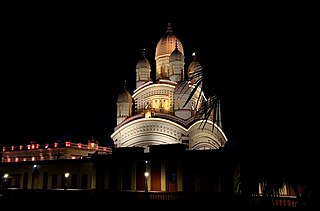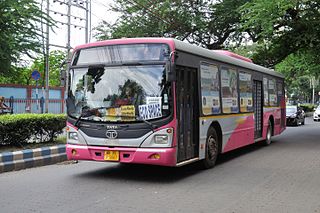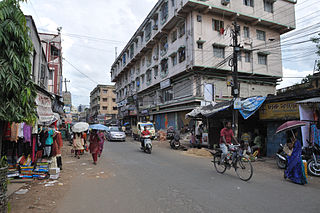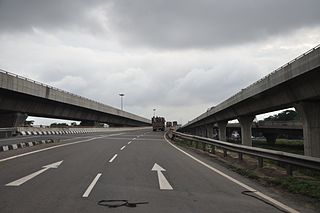
A cable-stayed bridge has one or more towers, from which cables support the bridge deck. A distinctive feature are the cables or stays, which run directly from the tower to the deck, normally forming a fan-like pattern or a series of parallel lines. This is in contrast to the modern suspension bridge, where the cables supporting the deck are suspended vertically from the main cable, anchored at both ends of the bridge and running between the towers. The cable-stayed bridge is optimal for spans longer than cantilever bridges and shorter than suspension bridges. This is the range within which cantilever bridges would rapidly grow heavier, and suspension bridge cabling would be more costly.

Howrah is a city in the Indian state of West Bengal. Howrah is located on the western bank of the Hooghly River opposite its twin city of Kolkata. Administratively it lies within Howrah district, and is the headquarters of the Howrah Sadar subdivision. It is the Third most populated city in West Bengal after Kolkata and Asansol. Howrah is an important transportation hub and gateway to Kolkata and West Bengal via Howrah Railway station and Howrah Bridge.

The Hooghly River or popularly called Ganga or Kati-Ganga in the Puranas, is a river that rises close to Giria, which lies north of Baharampur and Palashi in Murshidabad. It is the western distributary of the Ganges. The main course of the Ganges then flows into Bangladesh as the Padma. A man-made canal, built in the 1960s and early-1970s at Farakka, connects the Ganges, flowing through Malda, to the Hooghly to bring the abundant waters of the Himalayan river to the comparatively narrow river that rises in eastern West Bengal.

The Howrah Bridge is a balanced steel bridge over the Hooghly River in West Bengal, India. Commissioned in 1943, the bridge was originally named the New Howrah Bridge, because it replaced a pontoon bridge at the same location linking the cities of Howrah and Kolkata, which are located at the opposite banks of each other. On 14 June 1965, it was renamed Rabindra Setu after the Bengali poet Rabindranath Tagore, who was the first Indian and Asian Nobel laureate. It is still popularly known as the Howrah Bridge.

Vivekananda Setu is a bridge over the Hooghly River in West Bengal, India. It links the city of Howrah, at Bally, to Kolkata, at Dakshineswar. Completed on 1931, it is a multispan truss bridge and was built to primarily to provide direct road and rail connectivity between the Calcutta Port and the major railhead at Howrah railway station on the West bank of the Hooghly River. It is 2,887 feet (880 m) long having 9 spans in total. The famous Dakshineswar Kali Temple is situated on the banks of the Hooghly River near the bridge. The bridge is one of the four bridges linking Howrah and Kolkata. A new road bridge, the Nivedita Setu, was constructed 50 m (160 ft) downstream in 2007 due to weakening of the Vivekanada Setu caused by its ageing.

Dakshineswar is a locality in Kamarhati Municipality of North 24 Parganas district under the jurisdiction of Kolkata Metropolitan Development Authority (KMDA). This place is historically famous for Dakshineswar Kali Temple, locally known as Maa Bhabatarini Mandir.

An extradosed bridge employs a structure that combines the main elements of both a prestressed box girder bridge and a cable-stayed bridge. The name comes from the word extrados, the exterior or upper curve of an arch, and refers to how the "stay cables" on an extradosed bridge are not considered as such in the design, but are instead treated as external prestressing tendons deviating upward from the deck. In this concept, they remain part of the main bridge superstructure.

The Bandra-Worli Sea Link is a 5.6 km long, 8-lane wide cable-stayed bridge that links Bandra in the Western Suburbs of Mumbai with Worli in South Mumbai. It is the longest sea bridge, as well as the 5th longest bridge in India after Mumbai Trans Harbour Link, Bhupen Hazarika Setu, Dibang River Bridge and Mahatma Gandhi Setu. It contains pre-stressed concrete-steel viaducts on either side. It was planned as a part of the proposed Western Freeway that would link the Western Suburbs to Nariman Point in Mumbai's main business district, but is now planned to become part of the Coastal Road to Kandivali.

The transport system of Kolkata, a city in India, is a mix of modern mass rapid transport and old transport modalities like rickshaws. Kolkata is connected to the rest of India by the National Highways, the extensive network of the Indian Railways, National Waterways and by air. The most traffic to Northeast India route is via Kolkata.

Belgharia is a locality in Kamarhati Municipality of North 24 Parganas district in the Indian state of West Bengal. It is a part of the area covered by Kolkata Metropolitan Development Authority (KMDA) and a vital locality in Kolkata metropolitan area. Belgharia is also known for wholesale market for all types of Bags/Luggages/Purse etc. One must visit and check the Bag Market beside Belgharia Railway Station. Dakshineswar Kali Temple of Kolkata is in approximately three kilometers distance from Belgharia Railway Station. The Vivekananda Setu on the river of Hooghly which is one of the oldest bridge in Calcutta established for the connection between the city of Howrah and Kolkata is also at the adjacent area of Belgharia.

Bally is a neighbourhood in the city of Howrah of Howrah district in the Indian state of West Bengal. It is a part of the area covered by Kolkata Metropolitan Development Authority (KMDA).

Belghoria Expressway is a four-lane 16 kilometres (9.9 mi) long grade separated tolled expressway in the North Suburban fringes of Kolkata, West Bengal. It is a key arterial road, linking the terminal junction points of NH 16 and NH 19 at Rajchandrapur to Dakshineswar across Nivedita Setu and then to NH 12 at Dumdum/Kolkata Airport.

Vidyasagar Setu, also known as the Second Hooghly Bridge, is a toll bridge over the Hooghly River in West Bengal, India, linking the cities of Kolkata and Howrah.

The Jiaxing-Shaoxing Sea Bridge, sometimes shortened to Jiashao Bridge, is the world's longest and widest multi-pylon cable-stayed bridge. From end to end, it stretches 10.14 km (6.3 mi) across the Qiantang River estuary, at Shaoxing, Zhejiang, China. The main bridge is 2,680 m (8,790 ft) long and 55.6 m (182 ft) wide and carries an expressway with eight traffic lanes. Construction started December 2008, and the toll bridge opened for traffic on July 20, 2013.
The state of Bihar has a number of bridges, extending from few metres to a few kilometres. The history of long bridges goes back to the British Empire when the site for the Koilwar bridge was surveyed in 1851. Since then a number of small and large bridges have crept up. Some are even largest of their kind. Mahatma Gandhi Setu, joining Patna and Hajipur was India's longest river bridge from 1982 to 2017.

Arrah–Chhapra Bridge is the longest multi-span extradosed bridge in the world with a main bridge length of 1,920 m (6,300 ft). The bridge crosses over the Ganges River in India, connecting Arrah in Bhojpur district to Chhapra in Saran district of Bihar state. The bridge provides a roadway link between the northern and southern parts of Bihar. The bridge opened for public use on 11 June 2017.
The Kacchi Dargah–Bidupur Bridge, currently under construction, will span the river Ganges, connecting Kacchi Dargah in Patna and Bidupur in Hajipur in the Indian state of Bihar. Upon completion in 2023, the bridge will provide an easy roadway link between the northern and southern parts of Bihar and will connect two major national highways, linking NH 31 to NH 322.

The New Narmada Bridge is an extra dosed bridge, constructed at Bharuch, India. It is a 1,344 m (4,409 ft) long bridge, built over river Narmada on NH-8. The four-lane bridge is a part of larger project involving six laning of a section of NH-8 between Vadodara and Surat. It runs parallel to Sardar Bridge. It is the extradosed bridge with the longest spans in India, 144 m (472 ft) long.

The Atal Setu is a cable-stayed bridge in Goa that runs between Panaji and Porvorim. It carries National Highway 66 over the tidal part of the Mandovi River. It is 5.1 kilometres (3.2 mi) long, making it the third longest cable-stayed bridge in India. Two wheelers, three wheelers and bullock carts are prohibited from using the Atal Setu due to its height of 30 metres (98 ft). It officially opened on 5 February 2019.






















